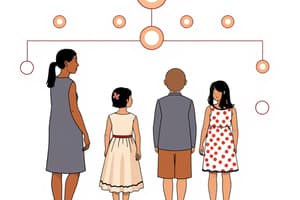Podcast
Questions and Answers
According to Robin Fox, the study of kinship primarily involves understanding what humans do with basic facts of life. Which of the following is NOT considered a 'basic fact of life' in this context?
According to Robin Fox, the study of kinship primarily involves understanding what humans do with basic facts of life. Which of the following is NOT considered a 'basic fact of life' in this context?
- Mating
- Socialization
- Gestation
- Education (correct)
In patrilineal descent, lineage is traced exclusively through the female line, granting women primary status and inheritance rights.
In patrilineal descent, lineage is traced exclusively through the female line, granting women primary status and inheritance rights.
False (B)
Define 'affinity' in the context of kinship studies.
Define 'affinity' in the context of kinship studies.
Kinship relations through marriage.
The practice of marrying within one's own group or clan is known as ______.
The practice of marrying within one's own group or clan is known as ______.
Match the following types of post-marital residence with their descriptions:
Match the following types of post-marital residence with their descriptions:
Which type of family is considered the most basic and consists of a married couple and their children living in an independent household?
Which type of family is considered the most basic and consists of a married couple and their children living in an independent household?
A household, by UN definition, must always consist of related individuals, unlike a family which can include unrelated members.
A household, by UN definition, must always consist of related individuals, unlike a family which can include unrelated members.
What is 'compadrazgo' and how does it function within kinship structures?
What is 'compadrazgo' and how does it function within kinship structures?
A ______ family is one where the members live apart for most of the time, but still maintain a sense of collective welfare and unity.
A ______ family is one where the members live apart for most of the time, but still maintain a sense of collective welfare and unity.
Which of the following is NOT typically cited as a primary function of the family?
Which of the following is NOT typically cited as a primary function of the family?
In an egalitarian family, authority is primarily vested in the eldest male, reflecting a patriarchal structure.
In an egalitarian family, authority is primarily vested in the eldest male, reflecting a patriarchal structure.
Define 'political dynasty' and explain its implications on local or national governance.
Define 'political dynasty' and explain its implications on local or national governance.
When authority is vested in the mother or the mother's kin, the family structure is described as ______.
When authority is vested in the mother or the mother's kin, the family structure is described as ______.
Which term describes the practice of having only one spouse at a time?
Which term describes the practice of having only one spouse at a time?
Exogamy requires individuals to marry within their own clan or ethnic group to maintain cultural traditions.
Exogamy requires individuals to marry within their own clan or ethnic group to maintain cultural traditions.
Differentiate between polygyny and polyandry.
Differentiate between polygyny and polyandry.
According to rules of descent, a ______ system affiliates an individual through the descent of one gender only.
According to rules of descent, a ______ system affiliates an individual through the descent of one gender only.
Match the following kinship concepts with their descriptions:
Match the following kinship concepts with their descriptions:
What is the main difference between matrilineal and patrilineal descent?
What is the main difference between matrilineal and patrilineal descent?
In a matricentric family, the father is always absent due to long-term work commitments or other factors.
In a matricentric family, the father is always absent due to long-term work commitments or other factors.
Flashcards
Kinship
Kinship
The web of social relationships forming a crucial part of human lives.
Affinity
Affinity
Human kinship relations established through marriage.
Descent
Descent
Relationships arising from one's origin or lineage.
Descent
Descent
Signup and view all the flashcards
Unilineal Descent
Unilineal Descent
Signup and view all the flashcards
Matrilineal Descent
Matrilineal Descent
Signup and view all the flashcards
Patrilineal Descent
Patrilineal Descent
Signup and view all the flashcards
Ambilineal
Ambilineal
Signup and view all the flashcards
Bilateral Descent
Bilateral Descent
Signup and view all the flashcards
Marriage
Marriage
Signup and view all the flashcards
Endogamy
Endogamy
Signup and view all the flashcards
Exogamy
Exogamy
Signup and view all the flashcards
Monogamy
Monogamy
Signup and view all the flashcards
Polygamy
Polygamy
Signup and view all the flashcards
Polygyny
Polygyny
Signup and view all the flashcards
Polyandry
Polyandry
Signup and view all the flashcards
Patrilocal Residence
Patrilocal Residence
Signup and view all the flashcards
Matrilocal Residence
Matrilocal Residence
Signup and view all the flashcards
Neolocal Residence
Neolocal Residence
Signup and view all the flashcards
Bilocal Residence
Bilocal Residence
Signup and view all the flashcards
Study Notes
Kinship
- Kinship is a social relationship forming a key part of most human lives.
- Anthropologist Robin Fox defined kinship study as examining human actions related to mating, gestation, parenthood, socialization, and siblingship.
- It can organize people into social groups and categories using kinship terminologies.
- Affinity signifies kinship via marriage.
- Descent describes relationships from one's origin group.
Kinship by Blood
- Families are categorized by descent rules.
- Descent signifies group members believing they share common ancestors.
Rules of Descent
- Unilineal descent affiliates individuals through one gender, either male or female.
Types of Unilineal Descent
- Matrilineal descent involves joining the mother's group at birth and remaining a member throughout life.
- Common in Native American societies (Crow, Cherokee).
- Children belong to women, tracing kinship through the mother, grandmother, etc.
- Patrilineal descent involves joining the father's group at birth, remaining a member throughout life.
- Seen in rural China and India where only males carry the family surname, giving them permanent family membership prestige.
- Females are seen as temporary members.
- Ambilineal descent allows children to choose lineage from either the father's or mother's family group.
- Frequent in Southeast Asia where parents can associate children with either parent's kinship.
- Bilateral decent considers both paternal and maternal ancestors part of the family.
- Sixty percent of societies, commonly modernized nations, follow this pattern.
Kinship by Marriage
- Marriage is a socially recognized or legal union establishing rights/obligations between spouses, their children, and in-laws.
- Marriage represents behaviors, norms, roles, expectations, and values linked to a legal union.
- It is at the core of any kinship system.
Types of Marriage
- Marriage selection can be influenced by:
- Endogamy, marrying within one's group/clan.
- Exogamy, marrying outside one's clan/ethnic group.
- Monogamy is having one spouse at a time or for life.
- Polygamy is the practice of multiple marriages.
Types of Polygamy
- Polygyny is one man having multiple wives/sexual partners, the most common form of polygamy.
- Polyandry is one woman having multiple husbands, a less common form of polygamy.
Post-Marital Residency Rules
- Residency after marriage typically aligns with descent rules.
- Patrilocal residence is where the wife lives with or near her husband's family.
- A married couple moves to the husband's father's community, allowing children to grow up in their father's location.
- Matrilocal Residence is where the husband lives with his wife's family.
- The husband may feel isolated.
- Neolocal Residence allows the couple to live separately, common in modern Western societies.
- Bilocal residence allows the couple to choose to stay with either the groom's or bride's family side based on wealth, status, and parental wishes.
Kinship by Ritual (Compadrazgo)
- Compadrazgo is kinship through godparenthood.
- Parents choose godparents at baptism, confirmation, and marriage.
- Parents often select close relatives as grandparents, strengthening kinship ties.
- A godparent ensures the godchild's upbringing if the parents cannot.
- Upper/middle-class urbanites choose friends/relatives as godparents.
- Those with limited financial means emphasize the child's economic benefits, not friendship.
Family and the Household
- The UN distinguishes between household and family.
- A household can be one person, whereas a family needs at least two.
- Household members do not need to be related, while family members must have a familial link.
- A family includes members connected by birth, marriage, co-residence, and/or shared consumption.
Functions of the Family
- Families regulate sexual behavior and enable reproduction.
- Families performs biological maintenance.
- Serves as the primary means of socializing children.
- Gives its members status.
- Functions as an important means of social control.
- Performs economic functions, typically in simpler societies.
- The family functions to produce and reproduce people biologically and socially.
Types of Families
- Nuclear Family is the core family unit, made of a married couple and children, forming an independent household.
- Extended Family contains other relatives like uncles, grandparents, and cousins.
- Reconstituted Family describes families with mixed parents where one or both parents remarried and bring children from the former family.
- Separated Family involves married people living apart informally or sharing residence without intimacy.
- Transnational Family members live apart yet maintain a sense of unity, called a "familyhood," extending across countries.
Based on Authority
- Patriarchal authority resides with the eldest male, usually the father.
- Matriarchal authority resides with the mother or her relatives.
- Egalitarian authority occurs when both the husband and wife exercise equal authority.
- Matricentric authority is in places where the father commutes or is frequently absent.
Politics of Kinship
- Political Dynasty is relatives with the same last name being repeatedly elected to local/national positions.
- Relatives appear to monopolize political power, disadvantaging rival leaders.
- Political dynasty members use wealth/access to public resources to favor themselves and keep followers loyal.
Alliances
- Alliances are formal agreements between countries for mutual support during war.
- Alliances provide combined action between independent states and are defensive, necessitating allies to join forces if attacked.
- They are created to maintain balance of power.
Studying That Suits You
Use AI to generate personalized quizzes and flashcards to suit your learning preferences.




